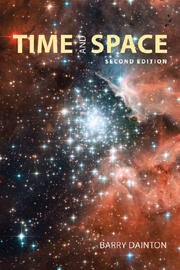Book contents
- Frontmatter
- Contents
- Preface to the second edition
- Preface to the first edition
- 1 Preliminaries
- 2 McTaggart on time's unreality
- 3 The Block universe
- 4 Asymmetries within time
- 5 Tensed time
- 6 Dynamic time
- 7 Time and consciousness
- 8 Time travel
- 9 Conceptions of void
- 10 Space: the classical debate
- 11 Absolute motion
- 12 Motion in spacetime
- 13 Curved space
- 14 Tangible space
- 15 Spatial anti-realism
- 16 Zeno and the continuum I
- 17 Zeno and the continuum II
- 18 Special relativity
- 19 Relativity and reality
- 20 General relativity
- 21 Spacetime metaphysics
- 22 Strings
- Notes
- Glossary
- Web resources
- Bibliography
- Index
20 - General relativity
- Frontmatter
- Contents
- Preface to the second edition
- Preface to the first edition
- 1 Preliminaries
- 2 McTaggart on time's unreality
- 3 The Block universe
- 4 Asymmetries within time
- 5 Tensed time
- 6 Dynamic time
- 7 Time and consciousness
- 8 Time travel
- 9 Conceptions of void
- 10 Space: the classical debate
- 11 Absolute motion
- 12 Motion in spacetime
- 13 Curved space
- 14 Tangible space
- 15 Spatial anti-realism
- 16 Zeno and the continuum I
- 17 Zeno and the continuum II
- 18 Special relativity
- 19 Relativity and reality
- 20 General relativity
- 21 Spacetime metaphysics
- 22 Strings
- Notes
- Glossary
- Web resources
- Bibliography
- Index
Summary
The limits of STR
In this chapter several threads of our inquiry thus far come together. Our topic is Einstein's general theory of relativity (gtr), the product of ten years' arduous labour, which followed the completion of str in 1905. During this intervening period Einstein wrote “never in my life have I tormented myself anything like this … Compared to this problem the original relativity theory [str] is child's play”. The metaphysical implications of this elegant and intriguing theory are of interest in their own right, for it remains our best account of our universe's large-scale spatiotemporal structure. But it is of interest for two further reasons.
Since gtr posits a variably curved spacetime manifold, it constitutes a challenge to Poincaré's conventionalism: the claim that, although non-Euclidean spaces are mathematically intelligible, we could never, in practice, have reason to accept a theory that ascribes a non-Euclidean geometry to our world. We will be looking into the considerations that led Einstein (and most other physicists) to accept a theory that does precisely this. gtr is also of interest in the light of the discussion in §§14.2–3, where we arrived at the conclusion that in worlds where material objects behave as if they inhabit a variably curved space, there is a strong case for supposing that the space in question is substantival rather than relational. We shall see that, although there are strong grounds for construing gtr in a substantivalist manner, there are also difficulties of a hitherto unsuspected variety.
- Type
- Chapter
- Information
- Time and Space , pp. 343 - 367Publisher: Acumen PublishingPrint publication year: 2010



